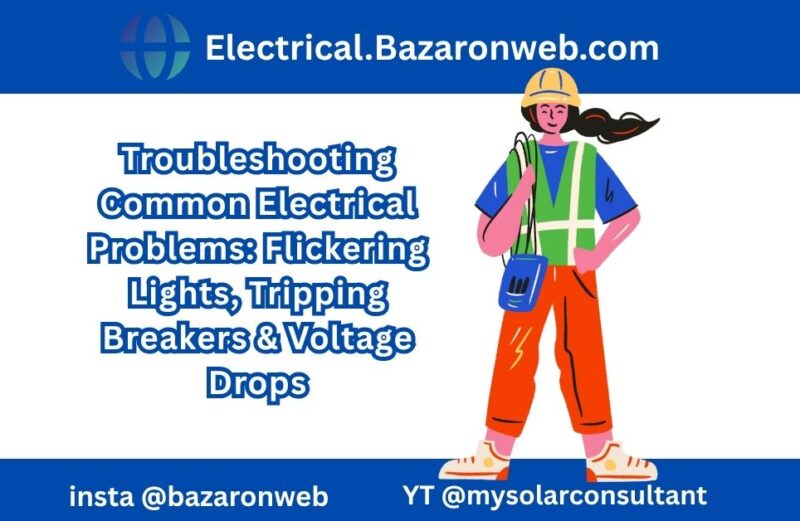I started my career as an Electrician, then I completed ITI from Electrical Technology and servers 5000+ Clients. I have seen technology changing in past 25 Years but the core concepts of Electrical Engineering or Physics never change. Electrical issues are among the most common (and often most frustrating) challenges homeowners face. Whether it’s flickering lights, a breaker that keeps tripping, or mysterious voltage drops, these problems can signal anything from minor wear-and-tear to potentially serious electrical faults.
In this guide, we’ll help you understand the causes, solutions, and when to call an electrician for three of the most frequently searched issues: flickering lights fix, breaker keeps tripping, and voltage drop causes.
⚡ 1. Flickering Lights Fix: Why Do Your Lights Flicker?
Few things are as annoying — or unsettling — as lights that blink or dim unexpectedly. Here’s what might be happening:
Common causes:
- Loose bulb or poor connection: The simplest culprit is a bulb not screwed in tightly or a corroded socket.
- Faulty light switch: Old or worn-out switches can cause inconsistent contact.
- Circuit overload: When large appliances (like air conditioners or refrigerators) kick on, they draw significant current, momentarily lowering voltage and causing lights to dim.
- Wiring issues: Loose or aging wiring connections behind outlets, switches, or in junction boxes can lead to flickering — and may pose a fire risk.
- Utility service problems: Sometimes, the issue comes from the power company’s supply.
DIY troubleshooting steps:
- Turn off power and check if the bulb is screwed in properly.
- Replace the bulb with a new one (especially if it’s fluorescent or LED, which can fail earlier).
- Check and, if needed, replace the light switch.
- Observe when flickering occurs — does it coincide with large appliances starting?
When to call an electrician:
- Flickering affects multiple rooms or the entire house.
- There’s a burning smell, buzzing, or hot outlets/switches.
- Lights dim significantly when large appliances run.
Tip: Regularly checking and tightening connections in accessible fixtures can reduce flicker risk.
⚡ 2. Breaker Keeps Tripping: What Does It Mean?
A circuit breaker is your home’s built-in safety device. When it trips repeatedly, it’s warning you something isn’t right.
Common causes:
- Overloaded circuit: Plugging too many high-power devices into a single circuit.
- Short circuit: When a hot (live) wire touches a neutral or ground wire, causing a surge of current.
- Ground fault: Similar to a short, but the hot wire contacts something grounded (like a metal outlet box).
- Faulty appliance: A damaged or aging appliance can cause intermittent trips.
- Old or worn-out breaker: Breakers themselves can wear out and trip more easily over time.
DIY troubleshooting steps:
- Identify what’s plugged in when the breaker trips — unplug one device at a time.
- Spread appliances across multiple circuits.
- Look for signs of damage on plugs, cords, or outlets.
When to call an electrician:
- Breaker trips immediately after resetting.
- Burnt smell or scorch marks on the panel or outlets.
- Tripping affects essential systems (e.g., HVAC, refrigerator).
Important: Never replace a higher-amp breaker to “solve” tripping — this can cause dangerous overheating.
⚡ 3. Voltage Drop Causes: Why Devices Lose Power or Perform Poorly
Voltage drop happens when electrical current travels a long distance through wires with resistance, leading to a drop in voltage at the end point. Small drops are normal, but significant drops cause lights to dim or devices to work inefficiently.
Common causes:
- Long wire runs: Wires to distant rooms, garages, or outdoor lights can lose voltage.
- Undersized wiring: Using smaller gauge wire than needed increases resistance.
- High-demand devices: Large appliances can draw enough power to lower voltage on nearby circuits.
- Corroded connections: Loose or corroded connections increase resistance.
Signs you might have voltage drop issues:
- Lights dim when you turn on appliances.
- Motors run hotter than normal.
- Devices work intermittently or fail to start.
Fixes:
- Upgrade to larger gauge wire, especially for long runs.
- Reduce the number of devices on the circuit.
- Fix or replace corroded or loose connections.
When to call an electrician:
- Voltage fluctuations affect large areas of the house.
- You’re adding new circuits for high-demand appliances (HVAC, EV chargers).
- Frequent device failures or overheating motors.
🛠️ Safety First: Know Your Limits
While homeowners can handle small fixes — like tightening bulbs, replacing switches, or redistributing appliances — anything involving the electrical panel, wiring inside walls, or repeated breaker trips should be handled by a licensed electrician. Electrical faults are a leading cause of house fires, so it’s worth the investment in safety.
✅ Quick Recap
| Problem | DIY Fixes | Call an Electrician If… |
|---|---|---|
| Flickering lights | Tighten bulbs, replace switches, check appliances | Flicker affects multiple rooms, burning smell, or loose wiring |
| Breaker keeps tripping | Unplug devices, redistribute loads | Trips immediately, burning smell, scorch marks |
| Voltage drop | Upgrade wiring, reduce load | Large voltage swings, adding big appliances |
🔧 Final Thoughts
Troubleshooting electrical problems like flickering lights, tripping breakers, and voltage drops is part of keeping your home safe and efficient. Start with simple checks, and always prioritize safety by calling a professional when needed.
By understanding why these problems happen and what steps to take, homeowners can reduce risks, save on repairs, and ensure everything runs smoothly — and safely — for years to come.

